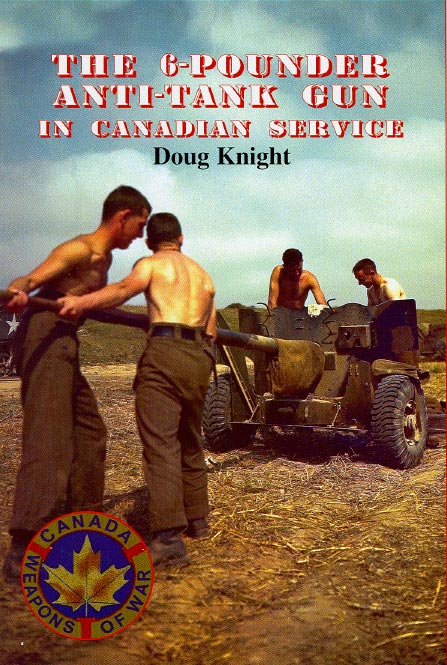"Weapons of War" Series;
The 6-Pounder Anti-Tank Gun in Canadian Service
by Doug Knight

Service Publications, Ottawa, Ontario, Canada, 2004; 24
pp. with B&W photos; price CDN $9.95; ISBN 1-894581-24-5 (http://www.servicepub.com)
Advantages: Neat little work on a popular but poorly covered weapon; good
clear photos of various versions of the weapon quite useful
Disadvantages: For the uninitiated a chart-type overview of which guns
have which features would have been helpful!
Rating: Highly Recommended
Recommendation: for all artillery and Commonwealth fans
Last year I began research on a special project (which,
alas, I did not complete) on the US version of the legendary "Six
Pounder" antitank gun – the US M1 – and found out there
was a lot about the little beast that I did not know, and even more about
the parent versions of the gun. Needless to say, when I received this
slim volume in the mail for review I was delighted, as it presents a good
deal of clarity on the subject.
I reviewed the previous publication by Doug Knight –
a former Canadian artilleryman – which covered the "Land Mattress"
rocket launcher and found it fascinating. The same is true here of his
treatment of this subject.
Both the US and the Commonwealth settled early on in the
war upon the British 6-lb antintank gun as their standard light weapon.
The British 2-lb gun and US M3 37mm were both found wanting for all but
basic light infantry support. The Commonwealth used the guns from 1941
onwards, the US from 1942 until the end of the war, and the US still used
some of their M1s in Korea as did the South Koreans.
Doug notes that over the course of the Commonwealth development
of the weapon it went through five versions: Mark I (prototype), Mark
II (initial production models), Mark III (Mark II barrel for mounting
in tanks), Mark IV (late models with a longer barrel and muzzle brake);
and Mark V (Mark IV barrel for mounting in tanks). The US M1 was very
similar to the Mark IV except for the muzzle brake and wheels used on
the carriage. Canadian built models had a C preface in their designations.
Due to the amount of area available for trials firing and
development, as well as the fact that Canada was not under attack, a good
deal of development on the 6-pounder took place in Canada.
Three carriages were developed for the 6-pounder; a Mark
I copy of the British design, a Mark II with improved suspension components,
and a Mark III which collapsed for air drop. Surprisingly, none of them
seem to have used the swiveling towing lunette used by the US Army with
the later versions of the M1 to prevent the barrel or trails from "digging
in" when crossing berms or ditches.
Nevertheless, the Dominion of Canada produced 8,000 6-pounder
guns and 8,000 replacement barrels, or about 10% of the entire Commonwealth
total production.
Armor penetration capability nearly doubled by the end of
the war, after Commonwealth metallurgists had developed a discarding sabot
round for the 6-pounder (from 74mm RHA at 1000 yards to 146mm at 1000
yards.) The gun had good results, notching the first German Tiger I knocked
out in North Africa (but I digress!)
While the US quickly settled on either the M2 halftrack
or the WC-62 Dodge 1 1⁄2 Ton Truck as a prime mover, apparently
the Canadians were not so fortunate, and a bit of squabbling took place
in the effort to select a proper prime mover. Some wanted the T16 Windsor
carrier, others the 6 x 6 3-ton Low Silhouette truck, and others still
either the CMP 60-cwt or Loyd carriers. After five months of testing and
arguments, the government selected the T16 as the winner in April 1944.
Most new guns went to the RCA regiments, infantry units
getting "hand-me-downs" as the others got newer or more powerful
weapons like the mighty 17-pounder.
Doug also covers the use of the 6-pounder on shipboard
or as the powerful automatic Molins installation in anti-shipping Mosquito
XVI fighter-bombers.
Overall, this is a good little reference work and again
sadly points up the fact for those of us in the modeling community of
a lack of a decent 6-pounder. The 35-year-old Tamiya feeble effort at
a Mark IV needs to be retired, and the 25-year-old Peerless/ITaleri/Zvezda
Mark II is better but has seen better days; ditto its M1 clone. But we
can hope!
Thanks to Clive Law of Service Publications for the review
copy.
Cookie Sewell
|